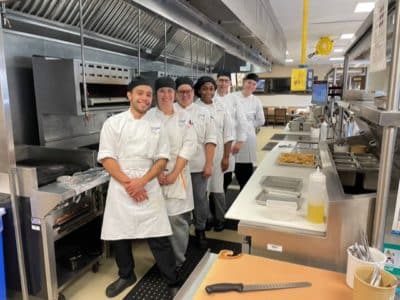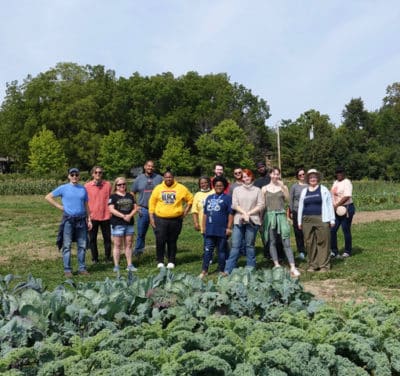
by Linda Halley
When you say, “Field to Fork” or “Farm to Table” in Wisconsin, Madison seems to get all the glory. But southeastern Wisconsin has some true pioneers in the movement who have done more than talk the talk – they walk the walk and even bring others along with them.
On an early December evening I put my feet by the fire and made a call to one of those pioneers, John Raymond, a Milwaukee area chef I am proud to call a friend. We met in 2018. I was a farmer, new to the area, with little understanding of the food scene in Milwaukee. I hoped to sell him some Gwenyn Hill produce and John took a chance on us. We earned his respect. Just as importantly, he earned ours, as well. We promised to grow him crazy things, like claytonia for his salads. When we surprised him with a bumper crop he held up his end of the bargain and bought it all. No doubt, all that claytonia caused some world-class eye rolls from his kitchen staff.

But true field to fork cuisine is built on relationships. We quickly understood that John had a “gardener’s worth” of knowledge about produce. At the time I didn’t know that was because he once was a gardener growing for his own before-its-time restaurant, Roots in Brewers Hill. When I met him as executive chef at Lake Park Bistro, John was eager for everything. From delicate french lettuces to the humble turnip, he knew one hundred ways to prepare them at their peak of flavor. The farmer-chef relationship with John developed into consistent, substantial orders making a drive in to Milwaukee worthwhile. For John, it meant he could count on his full order arriving on time and perfectly packed. But Gwenyn Hill floundered in finding other farm to table restaurants with which to build a similar relationship. And then came COVID.
Lake Park Bistro began an extended hiatus and John spent summer days in 2020 pitching in on Gwenyn Hill’s harvest crew in exchange for surplus veggies. By the time the restaurant scene was opening back up, John was ready to move on. He and his wife. Carla Haas, started Two Chef ‘Tosa, a catering and homemade meals concept with many Wisconsin sourced ingredients, of course. Gwenyn Hill has been lucky to work with John and Carla over the past two years. Carla bakes the cookies we sell in our farmstand, and John pulled off a most-amazing dinner here at Gwenyn Hill’s Williams Barn in September. The meal was magical.
But, the field to fork scene in southeastern Wisconsin is still a mystery to me. We have built connections with a couple of wonderful chefs, both part of Black Shoe Hospitality Group. But as we make plans for 2023, we ask, “is there a future in serving Milwaukee’s restaurants?” I value John’s perspective, hence the phone call.
He really gave me the scoop on how hard it is to truly be a field to fork chef. All those individual orders to place, and all those delivery schedules to juggle, when one call to the distributor saves so much time. There are farmers who don’t always get to the phone, who have unexpected shortages, or who don’t actually pack a professional box, all of which takes up extra staff time. And, no, local is NOT cheaper. Hand-picked, small scale, can’t compete on price with corporate farms. So, WHY then?
The chef has to have the passion to go the extra mile for flavor, for the local economy, for fewer food miles, for knowing how food is grown, for offering diners something unique they can’t get just anywhere. And importantly, perhaps what may have been not quite there 20 years ago when John was operating Roots, enough diners have to value it, seek it out and understand why.

To explore some more, I consulted another field to fork pioneer, Chef Jack Kaestner. Since the early ‘80’s, inspired by his time at Chez Michel in Madison, Jack’s cooking has always included fresh, seasonal foods from local producers. After a lifetime of living his local foods values as an executive chef, Jack is in a position now to influence the next generation of chefs. He teaches Culinary Arts at MATC. He has brought his class to Gwenyn Hill to get a sense of how and where local produce is grown. He places occasional orders for the campus restaurant, to familiarize culinary students with some lesser-known produce varieties.
Like John, Jack opened my eyes to what motivates a field to fork chef. For over 30 years Jack has worked with Wisconsin’s finest producers of grass-fed meats, dairy, vegetables, and fruits. He even participated in research to find out what makes these foods more healthful for us and the environment. His challenge now is to help new chefs understand the value of local foods. He is careful to pass on his passion with a dollop of hard reality. Not every student will land a job where they have the freedom to create seasonal menus or the budget to work with a wide array of local producers. Jack imparts the belief that strategic use of even just a few local ingredients can have a significant impact without breaking the bank.

As a young farmer, I saw this for myself. I was deeply moved by the reverence with which farm to fork chefs treated my produce. It validated my efforts and kept me going through the rough patches. I also saw how this appreciation of a farmer’s back door delivery spread through the whole kitchen staff. Not just a few went on to start their own farm to fork restaurants. When a community of small farmers begins serving a growing number of restaurants, rural communities benefit. And don’t discount the ripple effect on urban eaters. Restaurants are trend setters. When they showcase local producers, diners take notice. And when the growing number of families who buy fresh, local products to cook at home, dine out, why wouldn’t they choose farm to fork cuisine?
One of my New Year’s resolutions is to reach out and find more field to fork restaurants in our area. We will think of creative ways to solve the hurdles between the farm and the table. Can we piggyback on other trucks already stopping at the restaurants to eliminate excess delivery time? Can we adjust our planting to provide consistent supplies of what a chef regularly relies on? Can we make our ordering system more convenient? And, on the other side of the relationship, can a chef commit to a few key crops at pricing that works for everyone?
John, Jack, and my own farming experiences have convinced me that farm to fork cuisine is more than just a buzzy fad. It can, and does, have real positive outcomes for farmers, diners and restaurants willing to go the extra mile. As more and more of our meals are enjoyed out of the home, I hope you find a favorite farm to fork restaurant or two. All the effort and joy you put into sourcing sustainable local foods that you prepare at home can be mirrored when you eat out. Let’s all grow the movement. Bon Appetit.
Linda Halley has been the General Manager of Gwenyn Hill Farm since 2017.
